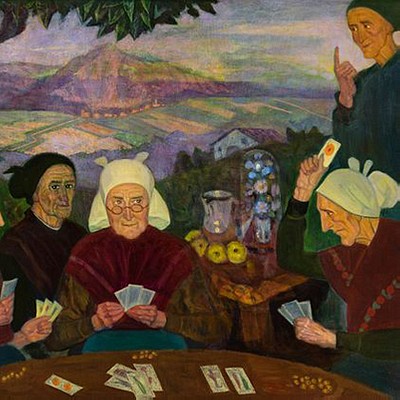ENRIQUE MÉLIDA Y ALINARI (Madrid, 1838 - Paris, 1892) "Procession of penitents in Spain in the seventeenth century", c. 1889. Oil on canvas.
Lot 125
About Seller
Setdart Auction House
Carrer Aragó 346
Barcelona
Spain
Setdart Subastas was born in 2004 and is currently the first online art auction in Spain with solidity, prestige and reliability guaranteed by our more than 60,000 users. Setdart has a young, dynamic and enterprising team ready to successfully manage the purchase and sale of art works through custom...Read more
Estimate:
EUR€11,000 - EUR€12,000
$11,827.96 - $12,903.23
Absentee vs Live bid
Two ways to bid:
- Leave a max absentee bid and the platform will bid on your behalf up to your maximum bid during the live auction.
- Bid live during the auction and your bids will be submitted real-time to the auctioneer.
Bid Increments
| Price | Bid Increment |
|---|---|
| EUR€0 | EUR€10 |
| EUR€200 | EUR€25 |
| EUR€500 | EUR€50 |
| EUR€1,000 | EUR€100 |
| EUR€3,000 | EUR€200 |
| EUR€5,000 | EUR€500 |
| EUR€10,000 | EUR€1,000 |
| EUR€20,000 | EUR€2,000 |
| EUR€50,000 | EUR€5,000 |
About Auction
By Setdart Auction House
Dec 14, 2021
Set Reminder
2021-12-14 08:00:00
2021-12-14 08:00:00
America/New_York
Bidsquare
Bidsquare : 19th & 20th Century Fine Art
https://www.bidsquare.com/auctions/setdart-auction-house/19th-20th-century-fine-art-7992
Gaudi, Sorolla, Torres Garcia, Maclet, TSUGUHARU FOUJITA, Benjamin Palencia Setdart Auction House sofia@setdart.com
Gaudi, Sorolla, Torres Garcia, Maclet, TSUGUHARU FOUJITA, Benjamin Palencia Setdart Auction House sofia@setdart.com
- Lot Description
ENRIQUE MÉLIDA Y ALINARI (Madrid, 1838 - Paris, 1892) "Procession of penitents in Spain in the seventeenth century", c. 1889. Oil on canvas. Presents label on the back with coat of arms of New South Wales (Australia). Measurements: 114 x 206 cm; 128 x 219 cm (frame). In the year 1889 the romantic painter Enrique Mélida was presented to the Paris Salon with this work in which a procession of penitents is represented. This theme of historical character was frequent in the salons, since this genre was the most valued by the academic critics. In this case the author proposes a procession in which he gives greater prominence to the figure of the penitents, also known as capirotes, since they stand out for their predominant position in the composition and for the brightness of their clothes that stand out from the dark tones used by the artist in the rest of the composition. The scene has been conceived as a sociological portrait, where various archetypes of 17th century Spain can be appreciated, from the religious to the common people, who are represented by the young girl in the lower right corner. The work was acquired by the Museum of Sydney, in fact, in the back area you can see a seal with the coat of arms of New South Wales, one of the six states of Australia. Spanish painter and critic. Son of the legal advisor Nicolás Mélida and brother of the archaeologist José Ramón and the architect and decorator Arturo. He initially followed in his father's footsteps, studying law and joining the Court of Auditors. He practiced painting as an amateur, having José Méndez and Ernest Meissonier as teachers. In 1864 he participated in the International Exhibition of Bayonne with two paintings, The Executioner and his Victim and Two Dogs' Heads, with which he obtained an honorable mention. Three years later he participated in the National Exhibition of Fine Arts in Madrid with Saint Clotilde surprised by her father, a Study and a Self-Portrait. These paintings were so well received that from that moment on he decided to devote himself entirely to painting and art criticism. He was one of the founders of the magazine El Arte en España, directed by Gregorio Cruzada Villaamil between 1862 and 1870, in which he published articles of historical-artistic erudition such as "La Escuela de Pintura de Madrid" and a study of Goya's etchings. In 1871 he again competed in the National Exhibition of Fine Arts with several costumbrist works influenced by Fortuny following the fashion of the casacón, and in 1876 he obtained a second class medal at the National Exhibition with the oil painting Se aguó la fiesta, one of the painter's best known compositions. His fame grew to such an extent that portrait commissions were numerous; the Prado Museum holds two examples of this activity: Portrait of a Lady and Doña María del Dulce Nombre González de Villalar, Marquise de los Castellotes. In 1882 he married Marie Bonnat, sister of the French painter Léon Bonnat, in Paris, where he lived until the end of his days. From there he continued to send works to the National Exhibitions of Fine Arts.
- Shipping Info
-
In-house shipping available. Please inquire at admin@setdart.com.
-
- Buyer's Premium



 EUR
EUR CAD
CAD AUD
AUD GBP
GBP MXN
MXN HKD
HKD CNY
CNY MYR
MYR SEK
SEK SGD
SGD CHF
CHF THB
THB
















